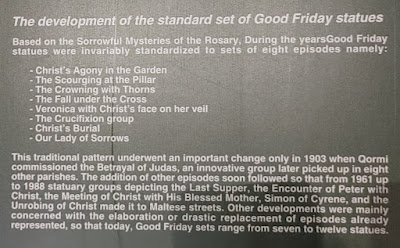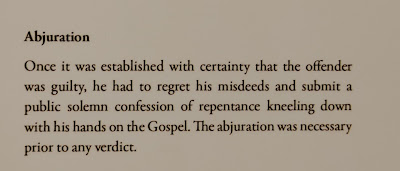 |
| Click on the photo to enlarge for reading. Here is what Viking had to say about this port. |
 |
| The boat is situated parallel to shore, so this panoramic shot takes in most of Valletta, although in a distorted way. |
 |
| Valletta is surrounded by defensive walls and forts. The ship is docked approximately in the middle of the bottom. |
 |
| From the ship looking straight down at the gangplank and Viking port tent. Viking has apples and hand sanitizer there when we get back on the ship. Crew also stands by when we exit to greet us. |
 |
| I would read this bus company's name as Cop Taco but I'm sure it has a different meaning from that. |
 |
| Some are definitely in better shape than others. |
 |
| To take the lift to the upper part of town, you would go through this entrance and pay €1 before approaching the elevator. |
 |
| There is a walking tunnel alongside the car tunnel. |
 |
| Within the tunnel is a chapel. Notice the Maltese Cross on the alter. |
 |
| We boarded a dgħajsa, a traditional Maltese water taxi that traces its roots back to the 17th century. |
 |
| We would embark at Valletta (top left blue X) and debark at Birgu (bottom blue X). |
 |
| As we leave shore, we see some colorful doors on the Valletta wharf. |
 |
| Another side of St Paul of the Shipwreck Church |
 |
| Crossing the Grand Harbour, we see Fort St Angelo on the left. It is in Birgu. Birgu is the Maltese name of this peninsula while Vittoriosa is its English name. |
 |
| On the right is Senglea |
 |
| Closer look at Fort St Angelo |
 |
| Yachts docked at Birgu. |
 |
| Birgu waterfront. As we approached Birgu, we could hear fireworks set off to observe the feast day of St. Lawrence, an early Christian martyr from Spain. |
 |
| In front is a stored Maltese water taxi, with more examples of Maltese balconies on the buildings. |
 |
| We departed the main channel and headed toward the waterfront. The church on the right is St. Lawrence's Catholic Church. |
 |
| Water taxis waiting to pick up passengers. |
 |
| St. Lawrence's Catholic Church was built by Lorenzo Gafa between 1681 and 1697. It is a fine example of Roman baroque architecture. |
 |
| We went around the left side of the church and saw this memorial. |
 |
| Looking up the street we see yet another entrance to the church. |
 |
| The Oratory of the St Joseph. |
 |
| This was another building across the alleyway. |
 |
| Next stop was a plaza with two statues. Due to construction in the area, the Statue of Victory was completely covered. We did get to see the statue of St Lawrence. |
 |
| Home of the Vittoriosa Stars Football Club, a Maltese football club from Birgu founded in 1906. |
 |
| Old phone booth maintained as a piece of history. |
 |
| Thrift shop. |
 |
| Ground floor layout of the Inquisitor's Palace. |
 |
| One of two Inquisitors that became Popes many became cardinals. |
 |
| Model of the town of Birgu |
 |
| Timeline of the building's history. |
 |
| Items left from the ground floors use as kitchens |
 |
| I'm assuming this symbol on a table in the courtyard was from the time of the Inquisition |
 |
| First flight of steps of the main staircase in the area where the Inquisitors lived. |
 |
| Ceiling over staircase. |
 |
| Main staircase looking down. |
 |
| Diagram of what we in the US would call the 2nd floor. |
 |
| I believe the top of the wall in the Chancery is ringed with the names and shields of each Inquisitor. |
 |
| The Ruffo Apartments contained many different displays. |
 |
| Carnival costume |
 |
| Inquisitor's bed chamber |
 |
| Inquisition process |
 |
| This short door was made this way so that everyone coming into the Tribunal room had to bow. |
 |
| Tribunal |
 |
| From the Tribunal, we headed down the stairs to the prison. |
 |
| Torture room. |
 |
| Prisoner's courtyard. |
 |
| Looks mighty comfortable, doesn't it? |
 |
| Male urination could take place here. |
 |
| On leaving the prison, prisoners had to take an oath not to reveal anything they had seen or heard in the prisons. |
 |
| Inquisitor's garden |
 |
| After the Inquisitor's Palace we walked back to the waterfront to reboard the boats for a harbor tour. |
 |
| There was time to explore so I walked around the roundabout in front of St Lawrence's Church |
 |
| I couldn't see the monument from the front due to the foliage. |
 |
| Looking to the waterfront taxi stand from the steps of St Lawrence. |
 |
| Smallest ice cream truck I've ever seen. |
 |
| We're back on the water for our harbor tour. First we travel back toward Valletta to get to the main part of the harbor. |
 |
| Back past the fancy yachts |
 |
| The Viking Saturn at port. |
 |
| Headed north toward Kalkara (next peninsula over) and The Ricasoli Fortifications. |
 |
| A great way to see what this harbor looks like is to go to Google Maps and drop the Streetview guy on one of the dots in the middle of the harbor. These are drone shots from up high. Wonderful! |
 |
| EsploraPlanetarium at Kalkara |
 |
| Head of Kalkara peninsula. |
 |
| The Harbour entrance looks quite small, but this photo is deceiving. They are angled so that one is approximately 2,000' further north than the other. |
 |
| Cave in the bluff supporting Valletta. |
 |
| Our guide told us that both abortion and euthanasia are crimes in Malta. |
 |
| Guess they wanted the water to run away from the bricks. |
 |
| Businesses along Quarry Wharf Road |
 |
| Cruise ship in dry dock. |
 |
| Once back on the Viking Saturn, we could see the water taxis queued up to take people across the harbor. |
 |
| Different view of Valletta as we sail out of the harbor. |
 |
| Looking NNW up the coast |
 |
| Lots of skyscrapers being built in the modern part of the island. Bye bye Malta. |
















































































































No comments:
Post a Comment